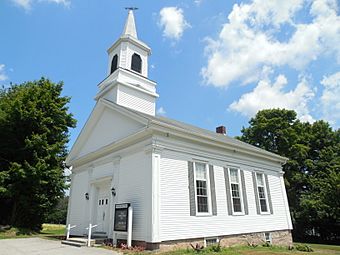Sterling Hill Historic District (Plainfield and Sterling, Connecticut) facts for kids
Quick facts for kids |
|
|
Sterling Hill Historic District
|
|

First Baptist Church of Sterling
|
|
| Location | Sterling Hill Rd. and CT 14A, Plainfield and Sterling, Connecticut |
|---|---|
| Area | 25 acres (10 ha) |
| Architectural style | Greek Revival, Italianate, Federal |
| NRHP reference No. | 86000152 |
| Added to NRHP | February 6, 1986 |
The Sterling Hill Historic District is a special old village in Sterling, Connecticut. It's like a time capsule from the early 1800s. You can find it where Plainfield Pike (also known as Connecticut Route 14A) meets Sterling Hill Road. This area has many houses and a church from the 19th century. What makes it unique is that it hasn't changed much over time. It was added to the National Register of Historic Places in 1986. This means it's an important historical site.
Contents
Exploring Sterling Hill's Past
The Sterling Hill area was first settled in the early 1700s. It was once part of a town called Voluntown. For a long time, not many people lived here. In 1794, Sterling Hill became its own town. By then, Plainfield Pike was a busy road. It connected Providence, Rhode Island to Hartford, Connecticut. Along this road, you could find a few homes and places for travelers to rest.
How the Village Grew
When Sterling became a town, it didn't have a main center or a church. In 1797, the town decided to build a town hall. Later, in 1812, a Baptist church group started using this building for their services. This building is now the Sterling Hill Baptist Church. In 1859, it was updated with a popular style called Greek Revival.
A Village Untouched by Industry
Many towns in the 1800s grew because of factories and railroads. But Sterling Hill was different. Factories were built elsewhere, and the railroad didn't come close to the village. The closest train station was in Plainfield. Because of this, Sterling Hill kept its old-fashioned charm. It looks much like it did many years ago.
What You Can See in the District
The historic district is mainly around the crossroads of Plainfield Pike. This is where it meets Sterling Hill Road (going north) and Connecticut Route 49 (going south). Besides the church, there are 14 houses in the district. These homes show different building styles. You can see Greek Revival, Italianate, and Federal designs.
Famous Old Homes
One interesting house is the Dorrance Homestead. It was built around 1716. This house has its original part on the right side of a big chimney. A newer section was added later on the left. This newer part has a Greek Revival style entrance. One house in the district even crosses into the nearby town of Plainfield.
A Stop for the French Army
The Plainfield Pike, which runs through Sterling Hill, is also very important historically. It was part of the route taken by the French Army during the Revolutionary War. This route is now known as the Washington–Rochambeau Revolutionary Route. The French soldiers, led by General Rochambeau, camped overnight in Sterling Hill. They stayed here twice, once in 1781 and again in 1782. Imagine soldiers from long ago resting right where these old houses stand!



